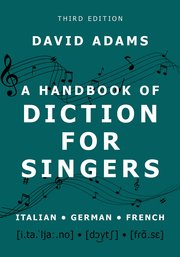"Finding Your Voice: Beginning to Master German Diction for Authentic Singing"
This is an article that aims to share my understanding of authentic singing. article aims to encourage singers at any level, especially beginners, to find their own unique voice and confidence in singing. As a singer, you are your best self… With examples of mostly personal experiences, I will share my insights on the journey of finding your own authentic voice and way of singing. I will be discussing norms in the singing world, addressing basic vocal techniques, and sharing tips and tools on how to get nerves out of the way and make your singing authentic.
It is common practice for singers to be categorized by “voice types”. Singers of the same voice type have similar vocal ranges, similar ranges where the voice sits most comfortably, and similar vocal transition points. “Soprano” categorizes the highest female voice; “mezzo-soprano” is the second highest and “alto” the lowest. Similarly, “tenors” are the highest male voices, “baritones” are the second highest, and “basses” are male singers with the lowest voices. There are hybrid terms like “bari-tenors,” which refers to men with baritone-quality voices but can sing tenor range. There are also subdivisions of each listed category into “lyric-, “coloratura-, and “dramatic-“, depending on what a singer can do and their tone quality. I can go on and on about categorizing voices; yet all we need to do as individual singers is to find our own voice and make the most of it. It takes time for anyone’s voice to take shape. it is normal if you are not quite sure about your voice type at the age of 30 as well; this is individual, too! In short, I believe that each singer has a unique and authentic voice that will shine on stage optimally if they find it and use it correctly. Just because you are a soprano doesn’t mean you are necessarily going to sound identical to another soprano. It’s the uniqueness of each voice that gives singers chances to show off their own authentic voice. Welcome to being a singer, an exciting lifelong journey of figuring out how your body and voice work and develop over time.
I was considered a mezzo-soprano for all my undergraduate years at least, and yet recently, I tested my voice range and found out that I can sing some of the tenor and soprano notes as well! With practice over the past few years, my vocal range has been expanding, and my tone quality has gotten better, too. Thanks to all the teachers, coaches, and directors who pointed out what might or might not be working in my voice and suggested what to do and not do to sing better. Some of my teachers are better at coaching classical singing; others specialize in musical theatre singing. I have also met directors who have, and insist on, their own methods of singing as those work the best for themselves. I realized over time that no matter the specialization of the teachers, all I have to take away from working with them are things that work best in my body and that help me to produce the best sound. This is the same for all singers. Do not get mad if you can’t sing with a good tone quality after a long period of time. It is going to come eventually as long as you keep singing with the proper technique and what works best for your body!
What comes to mind when it comes to vocal technique? Lift your soft palate? Support from your diaphragm to sustain long phrases? Head voice? Chest voice? Those are great technical things to keep working on, whether you have been singing for years or today is your first day of singing. The process doesn’t have to be fast! It will serve you immensely once you establish a solid vocal technique.
Breathing and supporting the voice are the most important things for me to keep working on. It is vital always to breathe in and out as low as possible and feel an expansion 360 degrees around the waist, and not only on the sides. I like to imagine the entire waist area being blown up like a balloon, and when singing, the goal is to hold the expansion as much as possible while making sure my breathing can happen freely so the support doesn’t become rigid. This is helpful in classical singing, and should also be done in musical theatre. Classical singing requires a warm, relaxed, and supported sound with the soft palate lifted high, whereas musical theatre singing emphasizes brightness more than anything else. Given this difference, it is still important to remember that in both classical and musical theatre singing, including belting, support from the waist area is needed to avoid vocal damage.
Mental stress and physical exhaustion are my biggest enemies in singing and have led me to significant stage frights, no matter how hard and much I practiced. So, I do my best to practice singing under minimum to no stress. I do yoga, sleep, hydrate, and eat the best I can, unless I am not allowed for any reason. I control the duration of practice sessions and try practicing with high quality. Practice journals help me to be aware of how I feel vocally before and after singing, to keep track of the length and quality of the session, and to be mindful of things that might or might not have worked. Unless I must continue singing, I try to stop immediately when my voice feels tired and resume when I am rested. If I must go to rehearsals when I am not feeling great vocally, I avoid singing too much so as not to push my voice. I try to listen to my body as much as possible and respond to its signs of need, whether I am singing or not, to reduce any stress that I might have been experiencing. This way, I get used to living with minimum stress and would be able to sing with low pressure more easily. I minimize singing before a performance. Before going on stage, I warm up my voice until it feels ready; I make sure to take some deep breaths, so I’m not as stressed. I also say to myself, “I got this,” and “I am excited.” Studies have shown that nerve energy is the same as that of excitement, and thinking positively helps in the transition between nerve and excitement. So why not?
Being present on stage is another key to overcoming stage fright. This includes supporting your voice and being precise with your pronunciation, so you sound in character. If permitted, having something visible with you on stage is a great idea, as that helps you remember your character and the setting of the piece. If there is a need to look at something or someone you sing about, actually see them!
I will address diction before long. For now, when you are working on a piece, pay close attention to how you say the words and what artistic choices you may want to make at a given moment. Allow yourself to play with options even while on the spot onstage as well. Have fun and enjoy the music!
Authentic singing is about telling a story and expressing emotions in a way that is authentic to the character. Vocal technique and musical details provide tools to enhance expression: chest voice may be added to show anger; a section can go faster and louder when things get exciting. Those can sometimes be up to the composer. The diction tools, however, are mostly up to you, the singer, to use to make your own music that is expressive in a way authentic to the original composition and to yourself as an individual artist!
As mezzo-soprano Joyce DiDonato would emphasize, diction serves a vital role in expressing emotions. Precise diction allows the audience to understand the lyrics of a piece, thereby connecting with its emotional content. Moreover, diction alone provides plenty of opportunities to elongate or modify vowels, aspirate consonants, and add glottal stops or not. Those all contribute significantly to characterization. It’s your choice to use or drop them to express the way you like! The use of diction tools allows another layer of expressiveness on top of what’s written on the page and, therefore, enhances the level of performance. In the next section, with the example of the German language, we will look at some tools of diction and discuss how they help with authentic singing and expression.
Vowels: The Heart of Diction and Singing

Vowels should be considered as the heart of speaking and singing in any language. They play a crucial role in filling the gaps between consonants and in carrying sounds. Vowels also help to pronounce a word correctly, so the right meaning is conveyed. Vowels are syllabic: there should be at least one vowel in each syllable of a word. In singing, vowels are always used to sustain notes of any value and, therefore, carry out words and phrases.
Vocal warm-up exercises are done mostly only on pure vowels and are helpful in opening up your voice and reminding your muscles of how to sing across your entire range healthily and optimally. While some warm-up exercises contain consonants or are on words, vowels are always the emphasis when doing those exercises.
Vocalises are performed pieces where melodies are sung on vowels of a singer’s choice. Pure open vowels like [aː] and closed ones like [iː] are valid choices; so are mixed vowels, vowels where you make the sound of one vowel within the lip shape of another. I strongly suggest, beginners especially, to put a single pure vowel on each phrase of a vocalise so as to get into the habit of sustaining a phrase on one vowel. Long musical phrases are frequently used in vocalises and are required to be sung in one breath. Working on them helps with breath support. Anchoring on solid but not rigid breath support, the singer has all the freedom to intensify any beats, play with different tempos, add ornamentations, etc., to add expression in vocalizes.
German vowels can be short or long, and each has a distinct way of pronunciation. The short [a] in "Apfel" (apple) is different from the long [aː] in "Vater" (father). I addition, an umlaut ( ¨ ) can alter the meaning of a German word. For instance, it can change a singular noun into a plural one. The umlaut can change the way a vowel is pronounced as well: a pure vowel can become a mixed vowel just by adding an umlaut, and this alters the meaning of the word. Always try pronouncing a word, especially a vowel, correctly so what you are saying is clear!
Two separate vowel letters and sounds can be placed in succession without anything in between. This is called a diphthong. Syllabic vowels are the most critical vowels, the one vowel in each syllable of a word that you hold the notes and phrases on. The first vowel of a diphthong is usually syllabic; the second vowel, unless set on a separate pitch from the first vowel, is generally not put on until right before an ending consonant is pronounced or the phrase ends
Undoubtedly, diphthongs in German play a vital role in pronunciation and expression. The only existing German diphthong sounds are [aɪ] or [ae] as in -ai-, -ei-, -ay- and -ey-; [aʊ] or [ao] as in -au-; and [ɔø] or [ɔʏ] as in -eu- and -äu- . It is impossible for the two vowel sounds in a German diphthong to be separated between two pitches, unlike in some languages.
In general, “the second vowel of a German diphthong is usually late and short” (Adams 2008, 101). This provides excellent opportunities to hold onto the syllabic vowel and play with it for as long as possible. If the “Freu-“ [frɔø-] part of the word “Freude” (joy), is set on two tied whole notes of the same pitch and the “-de”[-də] is placed on a quarter note right after that, the vowel sound to be held on would be [ɔ] and the [ø] would not be added until just before it’s time for the quarter note where “-de” comes in. Within the eight beats of holding the [ɔ], if counted in 4/4 time, you have all the time to add any dynamic changes or accents as the composer intended: as long as you come on “-de” at the right time, you are in good shape. The audience should not be able to understand a word until the end of it.
In the example of “Freude,” I would also subdivide each beat and almost add a tiny bit more intensity on every single subdivision for the long-held note on the “Freu-“. Not only does this keep the pitch from sinking, but it also helps to anchor the “joy” and intensify it. Although, depending on the context, you may not feel joyful when you say “Freude”. Whatever emotion you choose to convey, it gets intensified as the energy of the sound increases.
After all, vowels, whatever form or cluster they are in, are relied on in any vocal music to make continuous sounds and be expressive, so they are the heart of diction and of singing.
Consonants: The Backbone of Diction
If vowels are beams of laser light, then consonants are the laser pointers from which the light comes out. Consonants at the beginning of a word or phrase set the starting pitch as well as the vocal placement and support that serves the rest of the word or phrase. Consonants in the middle help sustain what is established. Ending consonants give the section a complete stop. The clearer each consonant is pronounced, the more your singing conveys.
German consonants can be hard or soft, and their pronunciation can change the meaning of a word. For example, "Tasche" (bag) and "Tasche" (pocket) are differentiated mainly by the hardness of the "T" and the "s" sounds. We surely want to use a meaning that fits the best within the context of a piece. So, pronouncing those and any consonants as they are supposed to be pronounced in the word that has the correct meaning is the goal.
A lot of German words have more than one consonant in a row. For example: “kn” is [kn]; “ps” is [ps]; and “pf” is [pf]. In most German consonant clusters, with a few exceptions, each consonant is to be pronounced separately, rapidly, and crisply; none can be neglected. This is a challenging but fun fact about German. I would suggest that students always exaggerate German consonants for practice's sake, to get into the habit of enunciating each of them clearly. This is an excellent practice for clarifying consonants in all languages, too.
German glottal attacks

In German, “words that begin with a vowel are usually initiated with a slight glottal stroke” (Adams 2008, 128). Such glottal strokes, or attacks, are marked as [ʔ] in the International Phonetic Alphabet (IPA) transcriptions before all words starting with a vowel. However, you don’t have to use it everywhere that is needed in transcription! Generally, glottal separations are required on “a word stem begins with a vowel” (Adams 2008, 129); this includes when such stem comes after a prefix ends with another vowel, in which case glottal separation is added between the two vowels. You must use them on important words within a phrase. Glottal attacks should also be used on a separated separatable prefix that starts with a vowel. For “compound adverbs beginning with ‘her-‘, ‘hin-‘, ‘dar-‘, ‘vor-‘ and ‘wor-‘ as well as in the isolated word ‘warum’” (Adams 2008, 129), no glottal separation is needed before the second part of the word. Glottal attacks are also not suggested to be used on unaccented words within a phrase. It is optional to use glottal attacks on unimportant words that start with a vowel. You have the option of whether to use a glottal attack or not on non-important words. Textual consideration at particular moments, alongside the music style and tempo of a piece or a phrase, contributes to the choice of whether to use it. Whether to use a glottal attack is a case-by-case situation, but it is a great tool to play with to express the desired emotion at a given moment! Choices are yours to make things you own! I love the fact that singers get to choose from a million artistic choices to suit what they desire at a given moment! Be YOURSELF and make the choice that you like best.
I will end this section with a personal experience. Coming to Canada after having spoken Chinese for most of my life, at one point during university, I decided to speak English with everyone on campus. I am happy that I did that because the daily practice of oral English helped me gain the muscle memory of how English is to be spoken and enabled me to be understood more in speaking and singing. The more I spoke English, the more I sounded like an English speaker and, consequently, the more authentic to the English-speaking characters I sounded in musical theatre songs and opera arias. It is not mandatory for singers to have lived in a country where German, English, Italian or French is the official language. However, it is a highly recommended step of learning a piece in any language to speak the lyrics first to at least get a flow of the language before adding the pitches.
In conclusion, discovering your own voice and developing a healthy vocal technique help singers in authentic singing, and so do making diction sound authentic to the role and to the language. I provided a great deal of tools for vocal technique and diction; and a lot more that could still be discussed about both. What I mentioned may be overwhelming to process, which is OK! It takes years of training to become a MET opera diva, and even divas continue to work on those things as well. I am delighted to help you to gradually develop a healthy vocal technique while being a mindful listener to your own body and to give you the tools to express the best possible in your pieces. Honour, love and enjoy the gift of your voice, and be patient in your singing. It is going to come eventually!
List of Cited Works




